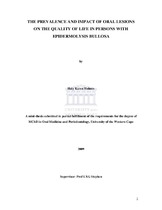| dc.description.abstract | Introduction:Hereditary Epidermolysis bullosa (EB) is a group of rare mechanobullous dermatological disorders in which blisters develop following gene mutations. These genes encode structural proteins that anchor the epidermis to the underlying dermis.There are four main types of Epidermolysis bullosa, with more than 20 subtypes. The medical, physical and psychosocial aspects of Epidermolysis bullosa are well documented (Lucky et al, 2005; Mellerio et al, 2005). Many studies have documented case reports of associated oral lesions (Silva et al, 2004; Pacheco and de Sousa Araugio 2008; Siqueira et al, 2008). However, no assessment of the impact of these oral lesions on the affected person's everyday life has been made. The morbidity of the oral lesions associated with EB is expected to have an impact on the quality of life of these patients.Aim:To assess the prevalence and impact of oral lesions on daily activities in persons with
Epidermolysis bullosa in Cape Town, South Africa, utilizing the Oral Impact on Daily Performance (OIDP) measure. Research Design and Methodology A case-controlled, descriptive analysis of the way in which oral lesions impact on quality of life in persons with Epidermolysis bullosa was carried out using semi-structured interviews. Fourteen persons with a confirmed diagnosis of hereditary Epidermolysis bullosa who attended the dermatology clinics at the Red Cross and Groote Schuur hospitals participated in the study. The control group comprised eighteen persons closely matched for gender, age, and dental status. Three persons with EB were unavailable for inclusion in the study.Results and Discussion Fourteen persons with Epidermolysis bullosa and eighteen controls were included in the study. Epidermolysis bullosa Simplex comprised the largest sub-group (n=9). Two persons had Junctional Epidermolysis bullosa, two had recessive Dystrophic Epidermolysis bullosa and one person had Kindler syndrome.
The oral manifestations observed were consistent with those reported in the literature(Chimenos et al, 2003; Silva et al, 2004; Pekinar et al, 2005). No significant oral lesions (other than tooth decay) were seen in persons in the Epidermolysis bullosa Simplex group. Oral ulcers, atrophy of the dorsal surface of the tongue and gingival erythema were seen in persons with Junctional Epidermolysis Bullosa. The two individuals with Dystrophic Epidermolysis bullosa had a maximal oral opening of 15mm and 24mm. Ankyloglossia, depapillation of the dorsal tongue, absence of palatal rugae and poor oral hygiene was seen in these two persons. The patient with Kindler syndrome presented with erythematous and inflamed gingiva and cratering in the maxillary anterior interdental area. The gingiva appeared desquamative, fragile and bled with even the slightest provocation. Healing peri-oral blisters and angular cheilitis was also seen. His
mouth opening was restricted to a maximal oral aperture of 13mm and his tongue
extrusion was limited to only the tip of the tongue passing over the lower anterior incisor teeth.Defects in the tooth enamel was recorded in both participants with Junctional Epidermolysis bullosa and one person with dystrophic Epidermolysis bullosa, as well as excessive occlussal tooth wear (attrition), which may have been secondary to enamel hypoplasia. The dental caries status of the Epidermolysis bullosa and control groups varied according to age. The dmf for persons with Epidermolysis bullosa (all of whom had Epidermolysis bullosa Simplex), was lower than in the control group. The DMF in EB persons (15.3) was higher than in the control group (10.1).Toothache and tooth decay were the most common perceived complaints in both the Epidermolysis bullosa and control participants, accounting for the high overall OIDP score in both groups (87.5%). No statistically significant difference was found between the two groups (85.7% and 88.9% for Epidermolysis bullosa and control group persons respectively).Conclusion:The results of the study show that oral lesions (particularly tooth decay and toothache) in persons with Epidermolysis bullosa do affect their daily activities and the impact thereof is high. Other oral manifestations, irrespective of the subtype, had little impact on the OIDP score. This may be because the EB persons become tolerant of and “learn to cope” with them.Recommendations:Epidermolysis bullosa is a rare condition and not all persons with EB will present with lesions. However, all health personnel (including oral health profession) must be cognizant of this condition, in order to manage these persons safely, without incurring harm inadvertently. Thus, the overall management of persons with Epidermolysis bullosa must encompass ways to minimize and prevent trauma; provide an optimum wound healing environment; provide pain management and judicious checks for the development of premalignant lesions. This necessitates a multidisciplinary and holistic approach, with emphasis on patient involvement. To this end, an oral health care programme should form an integral part of their management because of the risk of dental disease. Periodic recall visits will enable the monitoring of home care and minimize the need for advanced restorative procedures. In this way, one may reduce the impact any oral problems may have, so that they do not further influence the patients well being. | en_US |

